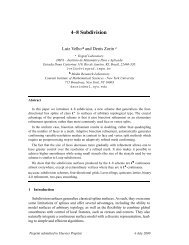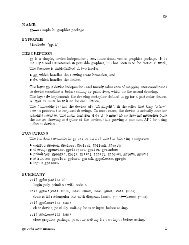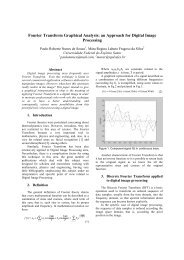Mathematical Optimization in Graphics and Vision - Luiz Velho - Impa
Mathematical Optimization in Graphics and Vision - Luiz Velho - Impa
Mathematical Optimization in Graphics and Vision - Luiz Velho - Impa
Create successful ePaper yourself
Turn your PDF publications into a flip-book with our unique Google optimized e-Paper software.
2.3. DISCRETE OPTIMIZATION PROBLEMS 25<br />
y<br />
3<br />
2<br />
1<br />
y<br />
6<br />
5<br />
4<br />
3<br />
2<br />
(1, 6)<br />
1<br />
2 3<br />
x<br />
1<br />
1<br />
2 3<br />
4 5<br />
x<br />
(a)<br />
(b)<br />
Figure 2.2: Discrete solution sets.<br />
It is important to remark that some types of discrete problems m<strong>in</strong>{f(x); x ∈ S}<br />
with solution set S, may be solved more easily by embedd<strong>in</strong>g S <strong>in</strong>to a cont<strong>in</strong>uous<br />
doma<strong>in</strong> S ′ , solv<strong>in</strong>g the new, cont<strong>in</strong>uous, optimization problem m<strong>in</strong>{f(x); x ∈<br />
S ′ }, <strong>and</strong> obta<strong>in</strong><strong>in</strong>g the solution of the orig<strong>in</strong>al problem from the solution <strong>in</strong> the<br />
cont<strong>in</strong>uous doma<strong>in</strong>. The example below illustrates this approach.<br />
Example 9. Consider the discrete optimization problem max{f(x) = 3x −<br />
2x 2 ; x ∈ Z}. In order to solve this problem we consider the similiar problem<br />
on R, that is, max{f(x) = 3x − 2x 2 ; x ∈ R}.<br />
The solution of the cont<strong>in</strong>uous problem is simple. In fact, s<strong>in</strong>ce f(x) is a<br />
quadratic function with negative second derivative, it has a unique maximum po<strong>in</strong>t<br />
given by f ′ (x) = 0, that is, 3 − 4x = 0. Therefore, the solution is m = 3/4, <strong>and</strong><br />
the maximum value is 9/8. Now we obta<strong>in</strong> the solution of the discrete problem<br />
from this solution.<br />
Note that the solution obta<strong>in</strong>ed for S = R is not a solution for the discrete<br />
case (because m ∉ Z). But it is possible to compute the solution <strong>in</strong> the discrete<br />
case from the solution of the cont<strong>in</strong>uous problem. For this, we just need to choose<br />
the <strong>in</strong>teger number which is closest to m. It is possible to prove that this provides<br />
<strong>in</strong>deed the solution. In fact, s<strong>in</strong>ce f is an <strong>in</strong>creas<strong>in</strong>g function <strong>in</strong> the <strong>in</strong>terval<br />
[−∞, m], <strong>and</strong> decreas<strong>in</strong>g <strong>in</strong> the <strong>in</strong>terval [m, ∞] <strong>and</strong> its graph is symmetrical with
















